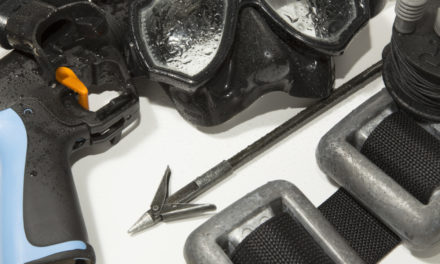Spearfishing Reel or Float Line – What Should You Use When Spearfishing?
Spearfishing is a fun and exciting extreme sport. Few outdoor activities can come close to the thrill of landing a quality fish.
Anyone can try their hand at spearfishing. It’s not hard, but it does require a good amount of practice.
The question we get asked the most is: what should you use when spearfishing—reel or float line? In fact, it’s an ongoing debate in the spearfishing community.
This led us to round up the various pros and cons of each type. So, keep reading to decide which is better for you and your spearfishing adventures.
Let’s dive in and learn more about these fishing rigs.
Spearfishing Reel vs Float Line
Now, let’s get down to business. Should you use a spearfishing reel or float line?
While it’s a straightforward question, the answer isn’t quite as easy to pin down. A quick answer would be either or both.
Basically, choosing one or the other depends on several factors. The main one is the condition of the water, which can vary from one area to the next, even from one dive to the next.
Spearfishing Reel
Almost all spearguns come with a line attached to them. Yet, some spearos prefer adding on a reel for added length and ease of use.
An average speargun reel should be between 100 and 150 feet. This is a pretty good length that allows you to keep a grip on the fish without the need to get directly to it.
When it comes to thickness, reels average between 2 and 3mm. Bear in mind that the 3mm reel can be too thick for many reels. On the other hand, the 2mm can be sharp enough to cut through your gloves if they’re too thin. So, a nice compromise would be a 2.5mm line.
Check out some pros and cons of using reels when spearfishing.
Advantages
A reel increases the length of the line on your speargun. So, once you’ve made a successful shot, you can swim to the surface for a breath. Then, start pulling in the fish at your own pace. Many prefer this rig because it gets the job done quickly and efficiently.
Reels are helpful when you’re out chasing fish that tend to stay toward the bottom of the water. The extra length of the reel ensures that you don’t run out of breath. At the same time, the fish tire themselves, making it easier for you to reel them in.
Another benefit of using reels is it gives you more freedom when you’re swimming underwater. You can maneuver around your diving buddy or underwater structures without fear of the line getting tangled or stuck.
Drawbacks
There are two main drawbacks to using a reel when spearfishing. The first is known as muzzle wrap, or when the reel line gets jammed around the speargun’s muzzle. This can be dangerous underwater, especially when you’ve caught a big fish that’s dragging you around.
Another drawback is referred to as reel jamming. When your reel jams in the spool, it’s usually caused by two factors.
The first cause is that the line free spools. When this happens, it means you don’t have the right drag tension to keep the reel in place. As a result, your catch can swim off and cause the reel to spool out of control.
The second cause occurs when the reel jumps out of the spool. This usually happens when you overfill the spool. Then, when a fish catches on, the reel line spills out of control.
Float Line
Float lines are lines made of braided plastic or plastic tubing. They’re connected to the rear of the speargun and designed to float on the surface of the water. This makes it more accessible to catch larger fish without tiring yourself out.
In general, it’s recommended that you have a third, or even half, more line than the depth you’re diving. So, if you’re diving in 49 feet of water, you need to be using 65 to 73.5 feet of float line.
Read ahead for more on their advantages and drawbacks.
Advantages
In simple terms, a float line acts as a visible line that helps you pinpoint and recover your catch. Not only that, but the trail of line you leave behind creates a reference for other boats in the area.
You can also attach a dive flag to the float. The flag will help make sure that surrounding boats are aware that there are divers in the area.
Float lines have hardware attached to each end. While spearfishing, you can attach your gear to this hardware. This reduces the risk of losing them in the water or having them float away. You can get to the surface for a breath of air while still maintaining a firm hold on your fish.
They’re also quite effective when you’re hunting one of the many types of game fish, and you need to wear it down. Even better is when you attach a float line clutch. This gives you better control over the float line and prevents it from being sucked down into the water.
Drawbacks
One of the main drawbacks of using float lines is they create an extra drag in the water. This is especially dangerous if there’s a strong current that’s hard to navigate.
Another drawback is that float lines tend to limit your freedom. You can’t use them when you’re spearfishing around big rocks, wrecks, or other obstacles. They can get you or your diving buddy tangled, which is a serious safety hazard.
Finally, float lines may draw unwanted attention to you and scare away the fish. It’s a minor disadvantage, but it’s still something to think about.
The Takeaway
So, are you new to spearfishing? Or are you an experienced spearo? In either case, you’ve probably wondered about what you should use when spearfishing.
Choosing a spearfishing reel or float line depends on your level of expertise and personal preference. If you’re a newbie, it’s recommended that you use a float line. Attached to a float at the surface, it offers a sense of security and reliability when you’re underwater.
Then, as you gain more experience, you can add a reel to your speargun. In the beginning, try it out with the float line still attached. As you practice more, you’ll be in a better position to decide which situation calls for which fishing rig.






